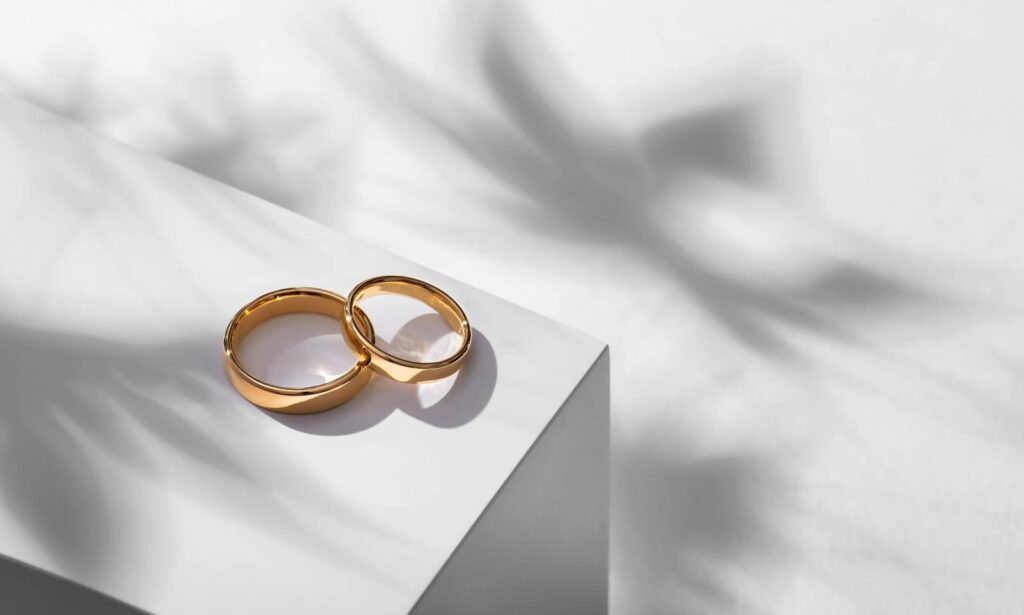
The history of the wedding ring dates back to about 5,000 years ago, to the time of the ancient Egyptians. The circle was considered the shape that represented infinity and was therefore ideal for the construction of amulets that sealed love and inseparable unions. The delivery of the ring, regardless of its material, was also a gesture with which the husband handed over to his wife the management of the house and its protection. This tradition did not stop even after the fall of Egypt with the Greeks and Romans.

The Roman wedding ring often featured the family crest, which included the wife, who often used it to seal drawers and preserves. The exegesis of Christian wedding rings is more curious: they were anything but simple rings, in fact they featured many symbols such as doves, intertwined hands and other designs. It was thanks to the Church, for which these artistic elaborations were all too reminiscent of paganism, that wedding rings took on the form we know today. The name wedding ring comes from the Latins: fides , in Latin, means faith; furthermore, Fides was also the Roman goddess of loyalty and faithfulness and vows made in the name of this goddess were considered the most inviolable. Wedding rings underwent another evolution during the Renaissance: the fashion of inserting engravings inside the rings dates back to this period. The engravings are of a private nature and this has also led to the transformation of the ring from a symbol of a merely commercial agreement between two families to a true symbol of love.

WHY IS THE WEDDING RING WORN ON THE LEFT HAND?
Another curiosity related to this iconic jewel is its position: why is it worn on the ring finger of the left hand? There are many theories, let's discover some of them. A probable explanation for the fact that the wedding ring is worn on the ring finger could be that in Latin the word for ring is “anulus”, a word from which “anulare” also derives. Chinese culture dedicates a very specific category to each individual finger of the hand: the thumb represents the parents, the index finger is dedicated to brothers and sisters, the middle finger to ourselves, the ring finger to the partner and the pinky to the children. The ancient Egyptians wore the wedding ring on the ring finger of the left hand because they thought there was a vein, the “ vena amoris ”, that went straight to the heart. According to Christian tradition, the wedding ring finds its place because the officiant touches the first three fingers of the hand while imposing the blessing, “in the name of the father, the son and the holy spirit”, then placing the ring on the fourth finger. A purely practical explanation is that the left hand is the one used the least and therefore the ring is less damaged. However, not all peoples put the wedding ring on the left hand: in Northern and Eastern Europe, for example, the wedding ring is worn on the right hand, as is in certain regions of Spain.
WEDDING RINGS: WHITE GOLD, YELLOW GOLD AND OTHER MATERIALS
As for the materials used to make wedding rings , they can be different, from silver and iron, used by the ancients, we moved on to using yellow gold first, then later rose gold and white gold. Another material that is increasingly in demand is platinum. Sometimes the bride's ring is embellished with diamonds or other stones. The diversity of materials is also accompanied by a diversity in shapes: the classic wedding ring , in yellow gold , varies from 3 to 10g, rounded on the outside and flat on the inside, which, like those of F.lli Pisa, can be embellished with diamonds on the inside. Another interesting model is the Mantovana ring , it is wider and flatter than the classic one. It is 6mm wide, flat on the inside and has a flatter curvature than the classic one and varies from 5 to 8 grams.
The French wedding ring is flat on the inside and slightly rounded on the outside. Very popular because it can be easily combined with other rings, while for gentlemen, not always used to wearing this type of jewelry, it is less invasive. The weight of this ring is about 5 gr. Finally, we have the comfortable wedding ring , which has both an external and internal rounded shape and whose weight varies from 3 to 10 gr.
Those described so far are obviously the classic wedding rings , which immediately bring to mind this type of jewel; there are others, the fruit of different cultures. Regardless of the shape and material, the true value of the wedding ring is the sentimental one, the symbolic charge that it represents.

